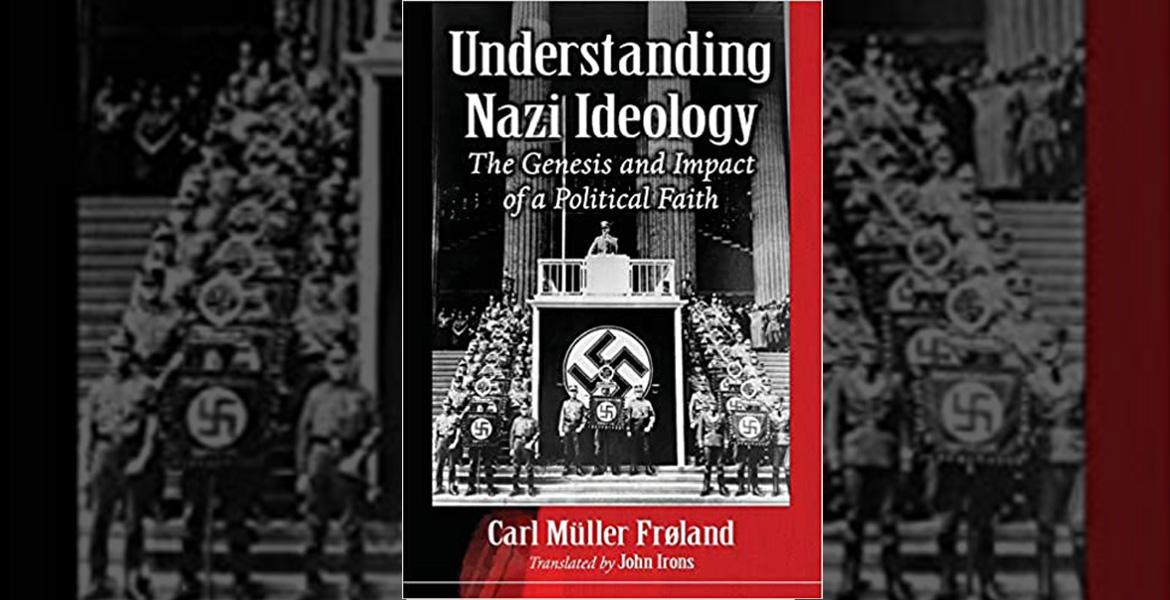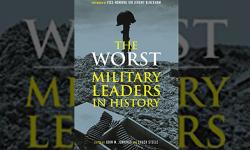Understanding Nazi Ideology, Carl Müller Frøland
In Understanding Nazi IdeologyA system of ideas and ideals., Carl Müller Frøland sets out to do just that: to get to the bottom of an ideology that is often considered confused, chaotic, and contradictory. In doing so, Frøland aims to answer some of the most important, but often overlooked, questions of Nazi history: ‘What are the origins of Nazism within the context of the history of ideas’; ‘Which conceptual elements did Nazism consist of, and what were its most important characteristics’; and ‘was it the actual driving force behind Nazi activity’? pp. 8-9.
pp. 8-9.
Despite the popularity of studying Nazi Germany, both among the general public and students, there are few examples of this sort of analysis. There are hundreds of narrativeA story; in the writing of history it usually describes an approach that favours story over analysis. accounts of the years 1933-1945 and almost as many looking in particular at the Final Solution and Nazi racial ideology in practice. There are biographies and psychological assessments of Hitler, there are military histories of the Second World WarA global war that lasted from 1939 until 1945., there are accounts of the rise of the Nazis and the fall of the Weimar RepublicThe unofficial name for the German state between 1919 and 1933.. Many of these are excellent and well worth a read, but there are considerably fewer studies that address where the Nazi worldview came from. There are some works that approach the subject – Michael Burleigh and Wolfgang Wippermann’s The Racial State, originally published in 1991, immediately springs to mind – but more often than not, any attempt to do so is confined to one or two small chapters. Worse still, the language used to address Nazi ideology is couched in such emotionally loaded terms – ‘brutal’, ‘murderous’, ‘horrific’, ‘barbaric’, for example – that it can cloud our ability to consider the subject objectively.
This is the gap that Frøland hopes to fill. Going back to its roots in pre-RomanticCharacterised by expressions of love; or an idealised way of looking at something; or someone who followed the Romantic artistic movement, that focused on individualism and emotion. Germany, he traces the trends of thought that contributed to Nazi doctrineThe set of beliefs upheld by a religion or political party. in the eighteenth, nineteenth and early twentieth centuries, before looking at how it was applied in practice. He takes us on a whistle-stop tour of the great, and not-so-great, philosophers and thinkers, from Johann Herder and Goethe to Nietzsche and Henri Bergson, carefully dissecting their ideas before weaving the relevant strands together to show how Nazi ideology was formed. The beauty of this approach is that it is comprehensive and coherent, allowing the reader to understand the genesis of Nazi ideology as a whole, rather than seeing it as different strands of opposing elements. The backwards- and the forwards-looking aspects, the reverence for both the peasant and the warrior, and the conflicting needs to submit and to exert one’s will – what Frøland terms the ‘organic’ and the ‘dynamic’ – are all explained and brought together into a surprisingly consistent whole. Although Frøland states that he does not intend to contribute to the SonderwegLiterally 'special path'. It relates to the theory that German history followed a particular, and very different, path from the rest of Europe, which created a set of unique circumstances., or ‘special path’, debate, the book as a whole, as well as a brief reference in his introduction, does lean towards the affirmative: he concentrates – with some obvious exceptions such as Darwin – on German philosophy and, while allowing room for the effects of losing the First World War, believes that the country’s history in ‘ideas and mentality … made many Germans emotionally receptive to Nazism’.  p. 284 It is, however, difficult to prove the point well without contrasting Germany with other countries, particularly when arguing that the shock of war, combined with the Versailles TreatyThe Versailles Treaty was the peace treaty signed at the end of the First World War. In reality, it was especially harsh towards Germany and has been called 'the twenty-year truce'. and the Weimar constitutionA body of fundamental principles and established precedents by which a state governs itself; or the composition of something., was not solely responsible for the success of the Nazi Party.
p. 284 It is, however, difficult to prove the point well without contrasting Germany with other countries, particularly when arguing that the shock of war, combined with the Versailles TreatyThe Versailles Treaty was the peace treaty signed at the end of the First World War. In reality, it was especially harsh towards Germany and has been called 'the twenty-year truce'. and the Weimar constitutionA body of fundamental principles and established precedents by which a state governs itself; or the composition of something., was not solely responsible for the success of the Nazi Party.
This absence of international comparison, and influence, is perhaps one area where the book is lacking. Tied to this is the lack of internal comparison: Frøland has provided an excellent description of the roots of Nazi ideology, but he does not comment on competing worldviews within Germany. A number of people were mentally and emotionally prepared for a Nazi government, but how many were not? What impact did they have on the development of Nazism? There is plenty of discussion, for example, of Ernst Jünger’s glorification of war in literature, but none of the opposing side, such as Erich Maria Remarque's All Quiet on the Western Front.  ch. 13. Yet this also, even if simply in a negative sense, had an impact on the intellectual climate of the Weimar Republic, and therefore on the growth of acceptable Nazi ideology: if it had not, then it would never have been banned.
ch. 13. Yet this also, even if simply in a negative sense, had an impact on the intellectual climate of the Weimar Republic, and therefore on the growth of acceptable Nazi ideology: if it had not, then it would never have been banned.
In addition to dissecting the foundations of Nazi ideology, Frøland considers its application during the Weimar era and beyond. As with the first section of the book, this is done in a chronological way, enabling discussion of changes in the practice of Nazi doctrine according to time and circumstance. As such, Frøland manages to show that neither the ideology nor the people were static: there was a fluidity that allowed short-term goals to be adjusted for long-term ends. Thus, Hitler chose to use democratic machinery in order to bring democracy down, and compromise was sought between the radicals and moderates over race policy in the early years of the Nazi government to avoid foreign criticism. Although Frøland does not extend the examples to their fullest capacity, this approach would also explain the seeming U-turn of the Nazi-Soviet PactA Non-aggression pact between Nazi Germany and the Soviet Union that was agreed in August 1939. The two countries agreed not to attack - or help others to attack - each other. Secretly, they also agreed to a division of Eastern Europe between them. and the emphasis on industrialization over an agrarian economy for the purposes of war. This flexibility is a new line of thought in studies of Nazi Germany, and one that thankfully moves away from older debates of intentionalist against functionalist, or modern against reactionary. It is not surprising, however, that Frøland makes reference to these old debates – and especially the idea that concluded many of them, Ian Kershaw’s notion of ‘working towards the Führer’ – given the centrality of the role of a ‘superman’ leader to Frøland's thesis, and he succeeds in merging his new concepts into these once stale arguments to create a seamless whole.
Coming from a history of ideas rather than a history of Nazism perspective, Understanding Nazi Ideology gives a fresh and valuable point of view, even if it does not provide a particularly finessed account of standard Nazi history: there are plenty of other books that do that. It is likewise refreshing to read a historian who clearly states that ‘The Nazis’ own way of thinking and their conception of the world must … be treated with an “open mind” – the person writing history must try to switch off his or her own value judgements in order to be able to maintain a (more or less) impartial understanding of the historical phenomenon.’  p. 7 Frøland aims to be objective and, by and large, he succeeds; enough time has passed that it is now easier to judge the events of the 1930s and 1940s in a dispassionate way. That lack of passion does not, however, always account for an easy read, and members of the general public might struggle to read what is, ultimately, an exceptionally detailed, in-depth text. Perhaps the translation does not help: although most of the time what one assumes to be translation errors are easy to overlook, occasionally they can muddy the clarity of a paragraph or, in one terrible example, confuse the determiner of ‘The Islamic State’ with ‘An Islamic State’.
p. 7 Frøland aims to be objective and, by and large, he succeeds; enough time has passed that it is now easier to judge the events of the 1930s and 1940s in a dispassionate way. That lack of passion does not, however, always account for an easy read, and members of the general public might struggle to read what is, ultimately, an exceptionally detailed, in-depth text. Perhaps the translation does not help: although most of the time what one assumes to be translation errors are easy to overlook, occasionally they can muddy the clarity of a paragraph or, in one terrible example, confuse the determiner of ‘The Islamic State’ with ‘An Islamic State’.  p. 4. A tiny mistake, but an unfortunate one.
p. 4. A tiny mistake, but an unfortunate one.
Despite this, Frøland’s thesis is important. Although Understanding Nazi Ideology was conceived as a crossover text - something to bridge the gap between academic and popular history - both its content and written style make it more appropriate for the former audience. His synthesis of the ideas that formed Nazism, of the events that made Nazism adapt, and of the people who led the movement, is detailed and convincing, turning the contradictory elements of the ideology into a coherent set of quasi-religious beliefs. In tracing the development of the Nazi worldview throughout the book, he really has helped the reader – be they members of the general public or of academia – better understand the essence of Nazi ideology.
- Log in to post comments







